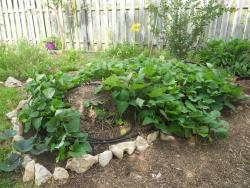
Waldo and Tilani, I have to admit I had to 'google' the word coppice and learned it simply means to cut them off as that is what I did.
I didn't know there was a problem of allelopathy with the Chinaberry, melia azedarach. I knew I couldn't use cedar which is readily available here in Texas. My neighbor cuts her tree back every year and I simply helped myself to those branches she had put at the curb for recycling to pick up. Had no idea I shouldn't use it.
I found this as part of a info article I read: Ecological Threat: Chinaberry outcompetes native vegetation due to its high relative resistance to insects and pathogens. Its leaf litter raises soil pH, thus altering soil conditions for native plants and seed germination. Chinaberry is a very fast growing tree that reaches 18 - 24 feet in height in 4 - 5 years. May reach 50 - 60 feet in total height.
Re your question about whether things are growing. I planted 4 cantaloupe plants and many acorn and butternut squash seeds. Only two cantaloupes survived and they were very small, but I think it was my fault due to lack of enough water. I wound up putting them in the trash. The squash seeds germinated like crazy, but we have had a great deal of rain during April and May so I think lack of insect activity to germinate was the reason I didn't get very many squash. (Maybe the bees didn't like the Chinaberry?) I did harvest a butternut squash yesterday and it seemed normal to me. I also have 8 sweet potato plants and they are growing nicely. Whether I actually harvest potatoes next month remains to be seen.
I was thinking ... when I built the hugel I used dried leaves and mushroom compost. Maybe that had something to do with the seeds and plants growing so well? Maybe in some way they counteracted the negative aspect of the chinaberry?
The bottom line is I haven't a clue. I've sure made many mistakes while attempting to garden in my small space. I've made every attempt to be an organic gardener so maybe my good intentions are helping things grow. Now that I know about the negative affects of the chinaberry I will most likely pull the chinaberry branches out of it and add something else. The base of the hugel is ash tree logs, or at least I think they are. I gathered them from another neighbor's recycling pile as well. HOWEVER, if I did up healthy sweet potatoes I will leave everything as it is.
Thanks so much for responding and I'll definitely let you know my results.
